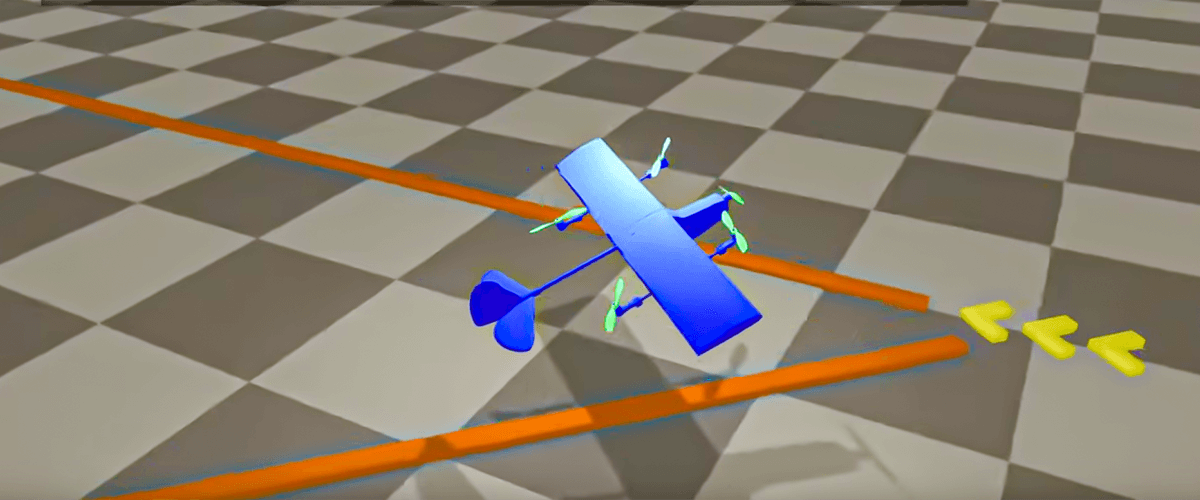You could now design your own hybrid drone and control system, even with no knowledge of aerodynamics, thanks to the work of the Massachusetts Institute of Technology.
Simulate flight
The team has designed a neural network that can simulate flight...
and optimize the control system of a hybrid drone. The user creates their own designs by mixing, matching, and manipulating parameters from a library of components. What this means is that even people with no idea what they're doing can design a hybrid drone. Awesome!
Design your own hybrid drone
The team developed a system where you can simply design your own hybrid drone in CAD. They developed a library of subcomponents, designed by experts; wings, fuselages, propeller mounts, etc. The shape and size of these parts is controlled by parametrics. There are also constraints that dictate how the parts can be assembled.

Five hybrid models used in the training. All were chosen for their very different shape and size. Image used for reporting purposes only. All copyright: Learning to Fly XU, DU, Foshey, et al.
The drone is then placed into a series of simulations where machine learning is used to generate a stable control system.
What's a hybrid drone?
Hybrid Drones are a combination of multicopters and fixed-wing planes.
Multicopters have excellent flight flexibility and stable hovering capability. However, they are aerodynamically unstable and require an onboard computer to stabilize them at all times.
Fixed-wing airplanes, on the other hand, are more stable and energy-efficient during level flight.
Hybrid drones combine these two designs to maximize efficiency. Even the US army is designing hybrid drones. However, their control systems are typically highly complex. This is because, in hybrid drones, aerodynamics change quickly and dramatically during flight.
There are also a huge number of ways to combine these two designs, which leads to a, quite frankly, baffling array of drone designs. All of this further complicates the design of the control system. For this reason, designers have been somewhat reluctant to explore hybrid drones.
How do you control a hybrid drone?
Typically hybrid drone controls are designed in three separate modes; "copter", "plane", and "transitional" (where both sets of blades are in motion). The design of the controls for this can bean extremely labor-intensive and highly complex task, due to the wide variety of design, shapes, center of gravity, and aerodynamic changes.
Until now the control system has been hardcoded. This new system uses a neural network that transitions between the three stages automatically.
It uses machine learning, which means that with every simulation of every design, the program gets better. In the future, the team hopes to be able to use calculations from the simulation of one design to assist with the calculations of the next.
They fed different drone designs into a simulation and ran it repeatedly until the computer could maintain stable and controlled flight.
Challenges

Comparison of a simulation flight to real-world testing. Image used for reporting purposes only. All copyright: Learning to Fly XU, DU, Foshey,et al.
As we all know computer simulation and real-life doesn't always align perfectly. The team added variables to the simulation to create a more "robust" testing state that would counteract the differences between reality and simulation.
Testing in real life

Real-world models made from CAD designs. Image used for reporting purposes only. All copyright: Learning to Fly XU, DU, Foshey, et al.
They successfully created real-life models of their drones and flew them using the control system that the simulation generated. Each of the hybrid drone design tested was deliberately very different.
The drones were fabricated using 3D printing, laser cutting, and manual assembly. The internal chassis were made from carbon fiber tubing with fiberglass-reinforced, 3D printed, nylon connectors. Whilst the wings were either constructed from laser cut foam or balsa wood and heat-shrunk plastic film. (Laser cut foam is more durable, while the heat shrunk wings have more effective lift.)
Incredibly, the same controller was used for all three real-world models!
Technical stuff
The flight controller was built on a modified version of ArduCopteron an open-source, Pixhawk flight computer hardware. The propellers were brushless electric motors.
Read the full paper.
What's next?
The team would like to develop the principles further to add in calculations for moving parts such as rudders. They would also like to generate an algorithm that could automatically suggest optimization of component parts during the design process.

